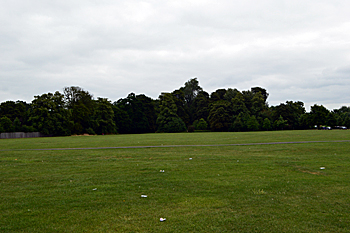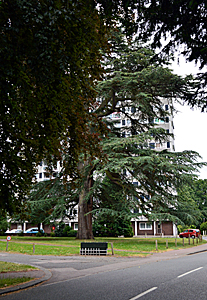Medieval Murder in Goldington
Volume 41 produced by Bedfordshire Historical Records Society in 1961 is devoted to 13th and 14th century coroner's rolls for Bedfordshire from the National Archives, edited and translated by R. F. Hunnisett. The first murder took place in 1266: “About bed-time on 8th August Ralph le Felun of Meppershall, Geoffrey le Veyere of Kempston and another unknown, who had been drinking above a louvre [presumably a shuttered window with louvred slats, which may have been a well-known feature of the building] in a Bedford tavern, went out and came into the king’s highway between Goldington and Bedford [no doubt today's Goldington Road] where a quarrel arose between them. Geoffrey and the unknown man assaulted Ralph, Geoffrey striking him to the heart with a “siklnas” knife [probably a sickle] of which he immediately died. The felons immediately fled. Ellen Estyne of Goldington first found him at dawn as she went to her work in the field and found pledges, William Coe and Henry the Clerk, both of Goldington. Inquest before the same coroner [Simon the Red] by Goldington, Renhold [and] Ravensden as one township and Great Barford, who said that Geoffrey killed Ralph with the aid of the unknown man, as above. Therefore Geoffrey’s arrest was ordered. They had no chattels”.
At the eyre it was presented that the quarrel arose in a tavern in Goldington. It was ordered that Geoffrey be exacted and outlawed. He had no chattels and was not in a tithing because he was a vagrant. The first finder had died. No Englishry was presented and so murdrum was imposed upon the hundred. Goldington was amerced for not arresting the felons although this happened in day-time.

Goldington Green from the west June 2017
“After vespers on 6th September 1267 a quarrel arose on Goldington Green between William the Red of Goldington and John of Goldington concerning sheep. William struck John in the face with an axe, giving him a wound, and John struck back at William with his “sparht” axe [perhaps a battleaxe], giving him a wound in the head between the crown and the hattrel [the nape of the neck] four inches long and to the depth of the bone. They later recovered from their wounds and were reconciled. After he had recovered [William] went to his work in the fields, to markets, and to wrestling matches, and on 17th August [1268?] he fell ill with ague and died the next day. His wife Margery raised the hue out of spite when he died”.
“Because the hue had been raised Simon the Red, coroner, held inquest by Goldington, Renhold and Ravensden as one township, Wilden and Great Barford. Goldington said that William did not die of the wound, from which he recovered, and they were reconciled, but of the said illness. The others agreed. It was ordered that John be attached”.
At the next eyre it was presented that John son of William of Goldington was found dead in his house at Goldington and that William the Red was attached as above. William came and was acquitted by a jury; nobody else was suspected. Thus either the original coroner’s inquest was wrong in describing the dead man as William the Red or the eyre is wrong in saying it was John of Goldington, son of William; there is now no means of telling which, but either way, it does not argue well for mediaeval record-keeping.
The third case keeps it in the family: “At dawn on 31st December 1268 Henry and William, sons of Richard the Carpenter of Goldington, quarrelled in their father’s house in Goldington about a halfpenny, which one of them had lent the other, and went forth quarrelling to the outer door. William then struck Henry on the head with a crab-apple staff so that he fell; he died by misadventure just after nightfall, William immediately fled. Their mother Hawise first saw [the body], raised the hue, which was followed by the neighbours, and found pledges, Walter of Roxton and Robert Hude of Goldington. Inquest before Simon the Red, coroner, by Goldington, Great Barford, Renhold, Wilden and Ravensden, who said as above and that William had no chattels. Two neighbours were attached: John de Mewes by Geoffrey le Cokere and Roger Bovetoun; Robert Careles by Henry Wigein and Henry the Clerk of Goldington. It was ordered that William be arrested”. A halfpenny was not quite so insignificant as it sounds - a penny was made of silver. Halfpenny coins of this date are very rare and it was common to simply cut a penny in half
Case number four involved highway robbery in 1275: “at twilight on 25th April an unknown felon was standing among the black-thorns below Putnoe by the king’s highway at Putnoe in the parish of Goldington [perhaps today's Putnoe Lane], when brother Ralph the Carpenter, a wood-seller, came with Henry the Hayward, a servant-boy. They wished to go to their lodging at Putnoe, but the felon stole a good coat of blanket and fourpence in coin from brother Ralph and a coat of “rosset” [russet] from the said Hayward and then ordered them to go home. They went to their lodging and immediately raised the hue, which was followed. The neighbourhood came, pursued the felon and found him below Putnoe Wood fleeing with the stolen goods and tried to arrest him, but could not because he defended himself with a bow and arrows and would not surrender. Therefore brother Henry le Granger’s servant Peter slew him in flight. Inquest before Ralph of Goldington, coroner, by Goldington, Renhold, Ravensden and Wilden: as above. Asked about the felon’s chattels [they said that he had] a bow with arrows worth threepence, a coat in poor condition with a white purse and a piece of horn worth one shilling and a penny-halfpenny and two knives worth threepence-halfpenny, which were delivered to Goldington”. At the eyre it was presented that the unknown thief stole from brother Ralph as above and that Hugh the Hayward of Putnoe and the said Peter then came and slew him in flight. Ralph, Hugh and Peter came to the eyre and were acquitted. The thief’s chattels were appraised at two shillings and forfeited. Putnoe was amerced for not coming to the inquest.

The site of Goldington Bury June 2017
Our final case is from over a century later: “On 18th July 1380 John Taverner of Atherstone [Warwickshire], recently servant of William Pykard, turned approver in the presence of Sir Giles Dawbeny, Sheriff of Bedfordshire, and before William Frensch and William of Fancott, county coroners, confessed that on the night of 1st December 1379 together with Stephen Cartere, servant of William Pykard, he came to William’s hall at Goldington [perhaps the site of the later Goldington Bury] and struck William in the head with an axe as he was sitting in his chair by the fire, so that he fell in the fire; and afterwards Stephen struck him to the heart with a “trenchour” knife [a knife used for eating, there being no eating forks in England at that date] of which he immediately died. He also said that Joan, William’s wife, allowed and procured Stephen to commit the felony, of which he appealed them. Stephen was brought before John Caundychs and his fellows at the Dunstable Gaol Delivery in the fourth year of Richard II [1380-1381] by the appeal of the said Joan, was found guilty of the homicide by a jury and so was hanged. John was hanged at Bedford [probably at Gallows Corner on Bromham Road] before the same justices in the same year, because he was suspected”. Joan was imprisoned and on 20th November was pardoned for her part in the homicide; she was said to have acted with Stephen Carter, John Clerc of Willingham, John Treschler, “Irisman” and others.
It would appear that Goldington was a uniquely violent place, recording more killings than anywhere else. However, more coroners’ rolls for the Barford Hundred seem to have survived than for other parts of the county. Certainly, the 13th century was a time of far more frequent casual violence than today, the numbers of killings per head of population being astronomical by modern standards. Most men went armed with a knife, a bow, a sword, an axe or a club and so quarrels would quickly descend to murderous violence, in the same way that they did in the Wild West due to the prevalence of firearms - outlaws, sheriffs and the posse are all American terms coming straight from the English Middle Ages.